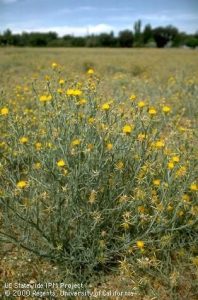Yellow starthistle is the thorny plants with yellow, spiny flowers you see along the roadsides especially near ranchlands in the late summer and fall. Wicked thorns make hiking painful, horseback riding treacherous and car rides just plain ugly. Yellow starthistle has now invaded more than 15 million acres in California alone and continues to spread.
This article is intended to address smaller invasions near homeowners, not large acreages such as ranchlands. One article I read stated, “Weeds know no boundaries, so yellow starthistle is all our problem, lend a hand!”
Though ‘eradication’ may be overly ambitious, multi-methods of management can greatly reduce the star thistle population and restore grasses and native plants that have been shoved and starved out of large areas. Yellow starthistle is a winter annual. One plant can produce up to 100,000 seeds! It propagates by seeds which are spread by hitchhiking on animals, people, undercarriages of cars, roadwork, and the digestive systems of birds and grazers. Seeds are viable for more than 3 years in the soil. The plant spends most of its resources in the winter and early spring developing deep root systems more than 3 feet deep, thus giving it the ability to absorb and drain water from surrounding areas, starving neighboring plants and enabling it to survive and thrive during the dry summer months. It is a major consumer of ground water. It needs full sun and strives to grow above its neighbors. It is poisonous to horses causing chewing disease which is fatal. Cows, sheep and goats will graze it up to a point in its development, something that enables some management of larger infestations.
Mechanical controls; hoeing and hand pulling can be employed once the plants are large enough to be identified. The rosette emerging resembles a dandelion. As it matures, it branches and sends up dark green shoots which will produce flowers. The plant must be cut below the surface or pulled. Do this BEFORE the thorns appear. Shallow hoeing, shovel or tillage is best, so as not to sow more of last year’s seeds on the soil surface. Late season management such as mowing, prescribed burning, or tillage requires precise timing of the flower production. It should be conducted before approximately 2% of the total spiny heads have initiated flowering. Seeds are viable 8 days after flowering, and it’s too late by then. Online images of the flowering stages will give you a good idea of what to look for. Mowing before this stage will simply reduce the height of the plant so that subsequent mowing will not be affective. Multiple tilling of the soil will not only destroy adjacent plants, but will promote additional germination of dormant weed seeds. Prescribed burning is outside this article’s range. Chemical control comes close to my definition of ‘nuclear weapons’ though it can be useful and necessary in large infestations. There is good information online regarding this.
The seed seems to need light for germination. One experiment we’re conducting as well, is mulching or composting areas where plants have previously emerged with the theory that if sunlight is inhibited, seeds will not germinate there.
We are into year two of our ‘persistence, patience and hard work’ project and I see promising results. The neighbor’s grandson appreciates the reduction of those horrible thorny plants that poke him when he’s exploring the area.
Yellow starthistle is not all bad. Honeybees love it, and apparently yellow starthistle honey is highly regarded and expensive. I guess there’s some good in everything. Having said that the damage to native plants, water conservation, grazing, and enjoyment of recreational activities is immense.
Nancy Bliss is a University of California Cooperative Extension Master Gardener of Tuolumne County.
UCCE Master Gardeners of Tuolumne and Calaveras Counties can answer home gardening questions. Call 209-533-5912 or fill out our easy-to-use problem questionnaire here. Check out our website here. You can also find us on Facebook.


